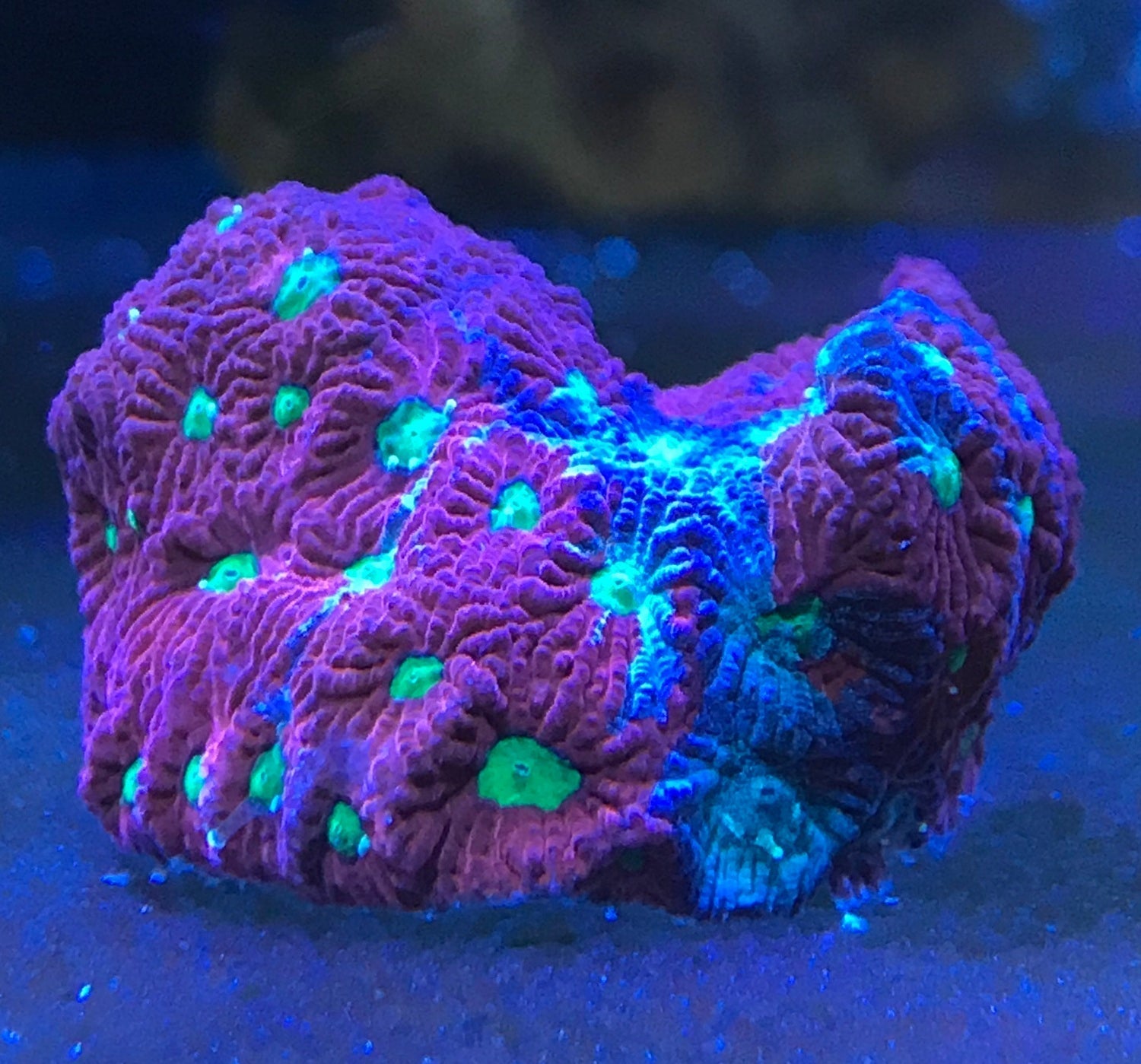
Micromussa Lord (Lord Coral) is a Must-Have for Your Reef Aquarium
If you’re looking to add bold color, mesmerizing patterns, and hardy growth to your reef aquarium, look no further than the Micromussa Lord, also known as Lord Coral. These vibrant, fleshy LPS (Large Polyp Stony) corals have become a favorite among Canadian reef keepers—from hobbyists to seasoned aquarists—thanks to their visual appeal and relatively easy care requirements.
Image submitted by: David P
In this guide, we’ll explore what makes the Lord Coral a top pick for your reef tank, how to care for it properly, and what to consider when placing or feeding it. Whether you're starting your first mixed reef or adding to an established coral garden, this article will help you make the most of this popular species.
What is Micromussa Lord?
Formerly classified as Acanthastrea lordhowensis, Micromussa Lord is a type of large polyp stony coral known for its thick, fleshy tissue and radiant coloration. Available in a spectrum of hues—bright reds, purples, greens, and even neon splashes—Lord Corals can dramatically enhance the aesthetics of any reef aquarium.
They form colonies made up of individual polyps, which can grow tightly together over time, creating a stunning carpet of living color. These corals originate from the Indo-Pacific region but are now widely propagated by aquaculture facilities, making them a sustainable and ethical addition to your tank.
Why Lord Corals Are Great for Reef Aquarium
Micromussa Lords are not only eye-catching but also practical for a variety of reef setups. Here’s why they’re a smart choice for your reef aquarium:
-
Hardy and forgiving: Great for intermediate hobbyists who want beauty without extreme sensitivity
-
Low to moderate lighting needs: Thrive under a range of reef aquarium lighting, from T5s to LEDs
-
Peaceful temperament: Won’t aggressively sting neighbors like some LPS corals
-
Feeding flexibility: Can benefit from target feeding, but also thrive off ambient nutrients in well-maintained tanks
These qualities make Lord Corals an ideal stepping stone if you’re transitioning from softies or zoanthids to more demanding LPS or SPS species.
Lighting & Placement: Finding the Sweet Spot
While Micromussa Lords are relatively flexible when it comes to lighting, they tend to prefer moderate PAR levels—usually in the 50–150 PAR range. Too much light can bleach their vibrant tissue, while too little can lead to sluggish growth or color loss.
Placement Tips:
-
Place Lords in the lower to middle regions of your reef aquarium.
-
Ensure moderate water flow to prevent detritus from settling while avoiding tissue damage.
-
Leave ample space around the colony—while generally peaceful, their sweeper tentacles can extend a bit during nighttime feeding.
Investing in a PAR meter or consulting your lighting specs can help dial in the ideal range. At Reef Supplies, we carry a range of LED fixtures and reef tank lighting options suited for LPS corals like these.
Feeding: Optional, But Rewarding
Micromussa Lords are photosynthetic, thanks to the zooxanthellae in their tissue, but they’ll grow faster and display brighter colors with occasional feeding.
Recommended Foods:
How to Feed:
Use a pipette or coral feeder to gently target feed the coral after lights go out. This is when they extend their feeding tentacles. You’ll be amazed how quickly they respond to the scent of food!
Keep in mind: overfeeding can raise nutrient levels, so monitor your nitrates and phosphates accordingly.
Water Parameters for Success
To keep your Micromussa Lord healthy and vibrant, you’ll need stable water parameters. Here are the ideal ranges:
| Parameter | Ideal Range |
|---|---|
| Temperature | 76–78°F (24–26°C) |
| Salinity | 1.025–1.026 SG |
| pH | 8.0–8.4 |
| Alkalinity | 8–11 dKH |
| Calcium | 400–450 ppm |
| Magnesium | 1250–1350 ppm |
| Nitrate | <10 ppm |
| Phosphate | <0.03 ppm |
Consistency is key. Sudden swings in alkalinity or salinity can stress the coral and affect its color or polyp extension.
Pro Tip: Use dosing systems or kalkwasser to maintain calcium and alkalinity levels, especially as your LPS corals grow.
Troubleshooting Common Issues
Even hardy corals like Micromussa Lords can experience issues if conditions aren’t right.
Shrinking tissue or receding polyps?
Check for:
-
Low alkalinity or calcium
-
High nitrates or phosphates
-
Too much direct flow
-
Aggression from nearby corals
Color fading?
You may be providing too much light. Try moving the coral lower in the tank or dialing down your LEDs.
If you're seeing persistent issues, a full water test is the first step. Reef Supplies carries reliable test kits and dosing solutions to help you quickly stabilize your system.
Growth & Propagation
Once your Lord Coral is thriving, you may notice new polyps budding from the base. This is a great sign of health and maturity.
You can propagate Micromussa Lords by carefully fragging the colony with a coral saw or bone cutters—just make sure each frag has at least one healthy polyp and some of the base skeleton. Always wear gloves and eye protection, as coral mucus can be irritating.
Fragged pieces can be mounted to frag plugs using reef-safe glue or epoxy and grown out under similar conditions.
Final Thoughts
The Micromussa Lord is one of the most rewarding LPS corals to keep in a reef aquarium. With manageable care requirements, dazzling colors, and peaceful tank behavior, it’s no wonder Canadian reef hobbyists are drawn to this coral.
Whether you’re building your first reefscape or adding a splash of color to your mixed reef, Lord Corals are a fantastic investment in both beauty and biodiversity.
Ready to start your Lord Coral journey?
While we don’t sell coral at Reef Supplies, we carry everything you need to support your LPS reef—from lighting and test kits to dosing pumps and coral foods.
Explore our reef aquarium supplies now » or contact us if you need help fine-tuning your setup.

